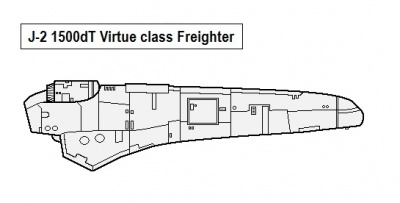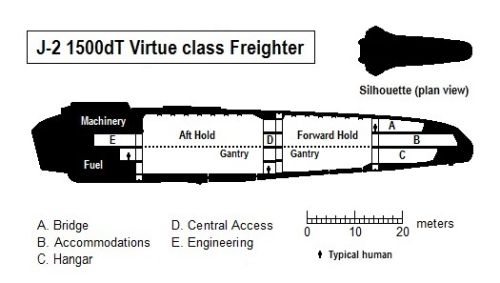Virtue class Light Freighter
| Virtue class Light Freighter | |
|---|---|
 | |
| Type: AK Subsidized Trader | |
| Category | ACS |
| Size | 1,500 Tons |
| Hull Configuration | Cylinder Hull |
| Streamlining | Streamlined Hull |
| Tech Level | TL–11 |
| Engineering | |
| Computer | Model/2 |
| Jump | J-2 |
| Maneuver | 1 G |
| Armaments | |
| Hardpoints | 15 |
| Offensive | 8 triple Missile turrets, 6 triple Sandcaster turrets |
| Accommodations | |
| Staterooms | 20 |
| Low Berths | 40 |
| Personnel | |
| Crew | 19 |
| High/Mid Passengers | 8 |
| Low Passengers | 40 |
| Payload | |
| Cargo | 800 Tons |
| Fuel tank | 330 Tons |
| Carried craft | 1 40t Boat |
| Construction | |
| Construction Time | 31 Months |
| Origin | Distant Fringe |
| Price | |
| Cost | MCr598.304 |
| Statistics | |
| Quick Ship Profile | RT-AS12 |
| Universal Ship Profile | AK–A221221–050000–40004-0 |
| Images | |
| Blueprint | Yes |
| Illustration | Yes |
| Source | |
| Canon | Unpublished, fan design |
| Designer | Ade Stewart |
| Design System | High Guard |
| Era | 1105 |
| Reference | Fan: Ade Stewart |
The Virtue class Light Freighter is a TL–11 Transport.
- Please also see: Ships of the Distant Fringe
Description
The Virtue class is a generic civilian vessel: it is a commercial transport commonly encountered along Star Lanes within the Distant Fringe region. It is classified as a Bulk Cargo Carrier and is constructed as a conventional design. Similar designs have been in use from the time the Distant Fringe was first settled.
- The vessel is a TL-11 design.
Image Repository
- A side view of a sleek Virtue class Light Freighter.

General Description & Deck Plans
The Virtue class is a streamlined flattened cone with a mean width of 26 meters, a mean height of 13 meters, and a length of around 92 meters. The hull is wider in some sections and narrower in others, it has large wings and the rear section has large machinery housings, giving the ship a total enclosed volume of approximately 20,250 cubic meters. There are three forward decks, a large forward cargo hold, four narrow central access decks, a large aft hold, and two rear engineering decks. The bridge, the accommodations and the hangar are located forward, while the cryogenic section and the secure locker are situated in the central access decks. The fuel tanks are contained within the wings and the stern.

A basic deck plan of the vessel indicating the general layout and positioning of major elements.
Basic Ship Characteristics
Following the Imperial Navy and IISS Universal Ship Profile and data, additional information is presented in the format shown here. The small craft factor indicates the number of squadrons (of ten craft) carried on the ship. Tonnage on the universal ship profile is shown in kilotons (thousands of tons) where necessary. [1]
| Basic Ship Characteristics [2] | ||
|---|---|---|
| No. | Category | Remarks |
| 1. | Tonnage | The Light Freighter is constructed using a 1500 dTon hull built in a generally conical configuration. The hull is streamlined and has good atmospheric capability: its atmospheric handling characteristics are heavily reliant on its onboard gravitic systems.
|
| 2. | Crew | Total Crew Complement: x19
Accommodations
There are x40 Low Berths. They are tended by the vessel's Steward. Accessible areas of the hull are fitted with grav plates and inertial compensators and have full life support and environmental systems.
|
| 3. | Performance | The vessel mounts a DeVoss-type Jump-2 drive, a Maneuver-1 drive and a Power Plant-2, giving performance of jump-2, 1-G acceleration and producing 30 Energy Points. The ship has an agility rating of 0 and an emergency agility of 1. The internal fuel tankage is sufficient for one Jump-2 and gives the power plant 4 weeks duration.
|
| 4. | Main Section / Electronics | Adjacent to the bridge is a Model/2 Computer: there is a backup Model/2 Computer.
|
| 5. | Hardpoints | x15 hardpoints. |
| 6. | Armament / Weaponry | The normal weapons fit-out for a Virtue is:
x8 triple Missile turrets, forming two batteries each of 4 linked turrets.
|
| 7. | Defenses | The hull is unarmored.
x6 triple Sandcaster turrets, forming three batteries each of 2 linked turrets The vessel is not fitted with screens or other passive defensive systems. |
| 8. | Craft | Flight Section
The subcraft is housed in a dedicated hangar located in the bows, close to the crew accommodations: the hangar can be sealed and has a total volume of 52 dTons. |
| 9. | Fuel Treatment | The vessel has internal fuel tankage of 330 dTons.
|
| 10. | Cost | The basic cost of the vessel, complete with a Ship’s Boat, is MCr747.879.
|
| 11. | Construction Time | 123 weeks (31 months) as standard.
|
| 12. | Remarks | Standard cargo capacity amounts to 800 dTons: this space is divided into a forward hold with a capacity of approximately 350 dTons and an aft hold with a capacity of approximately 450 dTons.
|
History & Background
The Virtue class is representative and a large number of variants exist, particularly with regard to the allotted weapons systems, onboard electronics, and the fit out of internal spaces. While they have spacious holds and adequate accommodations, the class are considered underpowered and a number of vessels have suffered catastrophic failure while operating in high-gee environments.
Class Naming Practice/s & Peculiarities
Vessel Peculiarities: No information yet available.
Class Naming Practice/s: A number of companies manufacture ships equivalent to the Virtue class. They vary in hull shape and internal layout but all share the same basic design and all have very similar capabilities and performance characteristics. Each variant class is named by the company that produces it: these organizations generally draw on traditional naming protocols. It is not uncommon for a historical class name to be reused. Individual vessels within a class are issued specific serial numbers and transponder codes but traditionally are named by their owners. This is considered a serious affair and a ship with a frivolous name is considered "unlucky".
Selected Variant Types & Classes
42 Representative Subsidized Trader (AK) Classes
A
- Akkigish class Subsidized Merchant
- Amkarim class Trade Liner
- Andrew class Commercial Shuttle
- Anhk class Merchant
B
C
D
F
G
J
- Jasper class Provincial Merchant
- Jelmirt Marquis class High Liner
- Jose Cadiz Royal Galleon class Cargo Carrier
K
L
M
- Maru class Merchant
- Mauripo class Subsidized Merchant
- Mavuzo class Super Freighter
- Mora class Freighter
P
Q
R
S
- Seeker class Armored Merchant
- Sirocco class Merchant Freighter
- Star*mart class Provincial Merchant
- Swordfish class Merchant
T
- Trader class Provincial Transport
- Type CT class Cargo Carrier
- Type R2 class Subsidized Merchant
- Type RL class Subsidized Merchant
- Type RL2 class Subsidized Merchant
- Tyrfing class Freighter
V
References
| This article has metadata. |

|
This ship was originally designed using one of the Classic Traveller ship design rules:
|
- Author: Lord (Marquis) and Master Scout Emeritus Adie Alegoric Stewart of the IISS
- ↑ Timothy B. Brown. Fighting Ships (Game Designers Workshop, 1981), 10.
- ↑ Timothy B. Brown. Fighting Ships (Game Designers Workshop, 1981), 10.